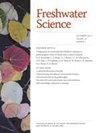Sulfur stable isotopes as a tracer of insect migration and consumption by fish predators
IF 1.6
4区 环境科学与生态学
Q3 ECOLOGY
引用次数: 0
Abstract
Resource flows between freshwater ecosystems can greatly affect foodweb dynamics. The seasonal movement of a family of aquatic insects, water boatmen, or corixids (Hemiptera: Corixidae) represents an important transfer of resources between wetland and river ecosystems. Corixids migrate en masse from wetlands in the North American prairies to rivers every autumn to overwinter. In the North and South Saskatchewan rivers, Saskatchewan, Canada, several fish species prey upon these migratory corixids. Here, we examined the utility of the stable isotope ratio of sulfur, δ34S, in tracing the migration of corixids between wetlands and the North and South Saskatchewan rivers. We also assessed the extent to which riverine fish use migratory corixids as a dietary subsidy. We found that both corixids and other wetland invertebrates exhibited a mean δ34S value of −10.5 ± 5.8‰, lower than riverine invertebrates at −4.1 ± 4.1‰. Specifically, riverine invertebrates from the South Saskatchewan River were more depleted in 34S than those from the North Saskatchewan River, with means of −5.1 ± 4.1‰ and −1.4 ± 2.8‰, respectively. In summer, corixid-feeing and noncorixid-feeding fish exhibited similar δ34S values in liver tissue, whereas in spring and autumn, corixid feeders exhibited more negative δ34S values. Isotope mixing models indicated that corixid-feeding species may have derived 34 to 65% of liver tissue from wetland sources in spring, 15 to 34% in summer, and 41 to 78% in autumn, whereas contributions to noncorixid-feeding species ranged from 4 to 17% across all seasons. We conclude that δ34S has the potential to trace insect movement and consumer use between isotopically distinct freshwater systems.硫稳定同位素作为鱼类捕食者昆虫迁徙和消费的示踪剂
淡水生态系统之间的资源流动会极大地影响食物网的动态。水生昆虫、水上船夫或珊瑚虫科(半翅目:珊瑚虫科)的季节性迁徙代表了湿地和河流生态系统之间资源的重要转移。科里西人每年秋天都会从北美大草原的湿地大量迁徙到河流中越冬。在加拿大萨斯喀彻温省的萨斯喀彻彻温河北部和南部,有几种鱼类捕食这些迁徙的珊瑚。在这里,我们研究了硫的稳定同位素比率δ34S在追踪珊瑚氧化物在湿地与萨斯喀彻温省北部和南部河流之间迁移中的效用。我们还评估了河流鱼类使用迁移性氢氧化物作为膳食补贴的程度。我们发现,珊瑚虫和其他湿地无脊椎动物的平均δ34S值均为−10.5±5.8‰,低于−4.1±4.1‰的河流无脊椎动物。特别是,南萨斯喀彻温河的河流无脊椎动物在34S中比北萨斯喀彻温河的更为枯竭,平均值分别为−5.1±4.1‰和−1.4±2.8‰。在夏季,喂食科里和非科里的鱼在肝组织中表现出相似的δ34S值,而在春季和秋季,喂食科里斯的鱼表现出更多的负δ34S。同位素混合模型表明,在春季,以珊瑚为食的物种可能从湿地来源获得34%至65%的肝组织,在夏季为15%至34%,在秋季为41%至78%,而在所有季节,非珊瑚为食物种的肝组织贡献率在4%至17%之间。我们得出的结论是,δ34S有可能追踪不同同位素淡水系统之间的昆虫运动和消费者使用情况。
本文章由计算机程序翻译,如有差异,请以英文原文为准。
求助全文
约1分钟内获得全文
求助全文
来源期刊

Freshwater Science
ECOLOGY-MARINE & FRESHWATER BIOLOGY
CiteScore
4.10
自引率
0.00%
发文量
49
审稿时长
6-12 weeks
期刊介绍:
Freshwater Science (FWS) publishes articles that advance understanding and environmental stewardship of all types of inland aquatic ecosystems (lakes, rivers, streams, reservoirs, subterranean, and estuaries) and ecosystems at the interface between aquatic and terrestrial habitats (wetlands, riparian areas, and floodplains). The journal regularly features papers on a wide range of topics, including physical, chemical, and biological properties of lentic and lotic habitats; ecosystem processes; structure and dynamics of populations, communities, and ecosystems; ecology, systematics, and genetics of freshwater organisms, from bacteria to vertebrates; linkages between freshwater and other ecosystems and between freshwater ecology and other aquatic sciences; bioassessment, conservation, and restoration; environmental management; and new or novel methods for basic or applied research.
 求助内容:
求助内容: 应助结果提醒方式:
应助结果提醒方式:


